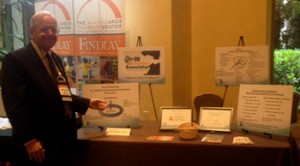When we work together with our people, we can shift the safety culture.
 The first part of this work is sharing all information and talking together about it. Another part is building trust and interdependence with the people as we openly discuss what is happening, what we are doing and why. The third part of this work is helping people to see the big picture and how important their part is to the success of the whole business.
The first part of this work is sharing all information and talking together about it. Another part is building trust and interdependence with the people as we openly discuss what is happening, what we are doing and why. The third part of this work is helping people to see the big picture and how important their part is to the success of the whole business.
These are the core elements of Self-Organizing Leadership. When we co-create our Safety Strategic Plan™ using the Process Enneagram©, we produce a living strategic plan that we use going forward. We keep it posted, talk about it weekly and modify it as things change.
We have found that walking around and talking with, rather than at, our people often feels new and awkward for many managers. It takes some practice and persistence.
Being in dialogue with the people makes us feel exposed and uncertain. Sometimes people ask questions we can’t answer. That is okay – just get the answer and go back to talk some more. This is not a spectator sport. There is a Spanish saying, “It is a lot easier to talk about the bull than be in the ring.” Yet, this walking around and talking and listening together is key to our success. In these conversations we are building the BOWL. This is the container that holds the organization together. It consists of our vision, mission, principles, standards, and expectations. As people learn to function within the BOWL, they find the freedom to create new solutions to problems, taking the lead to solve them and become leaders.
When the culture shifts in this way, the people begin to see other things that they can do to improve the business. Quality problems that were once ignored get solved. Cost problems that lingered get fixed. Customer issues among the plant and their customers, like delivery requirements, get solved. Turn-around times between production campaigns needed to clean and re-pipe the equipment drop from weeks to just days. I have seen all these things happen.
 Most of the safety people I’ve come to know approach organizations as if they are mechanical things to manipulate. Organizations are structured in functions. Knowledge is structured in pieces. People are narrowly skilled. Motivation is based on external factors. Information is shared on a need to know basis. Change is a troubling problem. People work in prescribed roles seeing only their part of the work. If change is needed people are moved around like chairs. Training is provided in abundance. Safety programs are set up as step-by-step processes where things are arranged in a prescribed sequence.
Most of the safety people I’ve come to know approach organizations as if they are mechanical things to manipulate. Organizations are structured in functions. Knowledge is structured in pieces. People are narrowly skilled. Motivation is based on external factors. Information is shared on a need to know basis. Change is a troubling problem. People work in prescribed roles seeing only their part of the work. If change is needed people are moved around like chairs. Training is provided in abundance. Safety programs are set up as step-by-step processes where things are arranged in a prescribed sequence.  It was fascinating to see the contrast between the usual, linear, mechanical approach to safety and The Complexity Leadership Process (CLP) that I discussed at my display table. A large number of people talked with me at my display table about The Complexity Leadership Process which was new to all of them. Many could not believe how quickly and dramatically the safety performance improved using the CLP. At one level the CLP looks like a simple employee involvement program, yet it is much more and also different at a deeper level than the usual employee involvement processes. One fellow, who recently wrote a book about changing the safety culture to excellence just brushed the CLP aside as something he’d already seen. The approach to safety excellence he’s written about involves 43 linear steps that take 3-5 times as long as the CLP and require a very high level of persistence and determination over many years.
It was fascinating to see the contrast between the usual, linear, mechanical approach to safety and The Complexity Leadership Process (CLP) that I discussed at my display table. A large number of people talked with me at my display table about The Complexity Leadership Process which was new to all of them. Many could not believe how quickly and dramatically the safety performance improved using the CLP. At one level the CLP looks like a simple employee involvement program, yet it is much more and also different at a deeper level than the usual employee involvement processes. One fellow, who recently wrote a book about changing the safety culture to excellence just brushed the CLP aside as something he’d already seen. The approach to safety excellence he’s written about involves 43 linear steps that take 3-5 times as long as the CLP and require a very high level of persistence and determination over many years.




